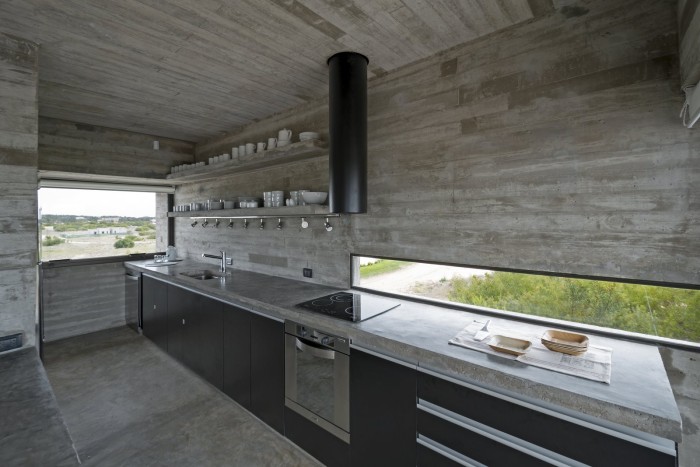Concrete’s affordability, high formability, and exceptional durability make it a favored material for homes looking to optimize space and enhance the functionality of their kitchens. One of the main attractions of concrete countertops is their ability to fit into a variety of kitchen layouts and sizes. With its exceptional malleability, concrete can be molded and shaped to fit specific dimensions and design requirements, providing homeowners with the flexibility to maximize limited kitchen space. This customization allows families to realize the full value of their kitchen area by incorporating functional and personalized countertops that meet their individual needs.
Additionally, when properly sealed, concrete countertops possess an impressive range of qualities, making them a resilient and long-lasting choice for kitchen surfaces. Notably, concrete has excellent scratch resistance, effectively maintaining its aesthetic appeal over time. It is also resistant to high temperatures, making it suitable for use near cooking areas and ensuring longevity under regular exposure to high temperatures. Additionally, the strong durability of concrete countertops ensures they can withstand the rigors of daily use, making them a practical and reliable choice for modern kitchens.
As an affordable, adaptable, and durable material, concrete has become a popular choice for homeowners looking to enhance the functionality and beauty of their kitchens. With its unique combination of properties, concrete countertops are reshaping the way home kitchens are designed, providing customizable solutions that maximize space utilization and durability while maintaining an appealing aesthetic. Overall, the growing popularity of concrete worktops highlights the growing emphasis on practical and customizable options in kitchen design, signaling a shift towards personalized and space-saving solutions in modern homes.
The versatility of concrete combined with different pigments and materials offers endless options for those looking to inject a unique and personal touch into their kitchen decor. The ability to mix concrete with a variety of pigments and stains has become a source of inspiration for individuals seeking to create unconventional and eye-catching countertop designs. This method attracts the attention of DIY enthusiasts, who enjoy the opportunity to experiment with different color combinations and thus achieve unique effects that match personal preferences and interior decoration concepts.
Additionally, the potential to enhance the mix of concrete with materials such as natural stone aggregate or recycled glass aggregate drives the creation of countertops with different textures and visual appeal. The combination of these elements brings a unique beauty that when polished creates a stunning luminosity that changes the raw appearance of the concrete. This shift allows countertop designs to not only complement the kitchen space but also become an eye-catching focal point in the home.
The appeal of DIY homemade concrete countertops is the opportunity for individuals to craft a unique, personalized design that reflects their creative vision. This surge in interest has led many people to consider undertaking projects to create their own custom concrete countertops, ultimately improving the overall ambience of their living areas.
After seeing this, do you also want to DIY an exclusive customized concrete countertop?

Below we will give you a brief introduction to the production steps:
1. Material
Cement, carving knife, bucket, trowel, brush, rag, tape, sandpaper, sander, vacuum cleaner, concrete sealing and curing agent, special wax for concrete countertops, face mask, etc.
2. Preparation
The first step involves cleaning and removing the original countertops and removing the sink, stove, and other components. If starting entirely from scratch, use plywood to construct the base, customizing it to the size of the kitchen and the needs of the homeowner. An outer fence was then built along the edge of the site to form the basic framework. A metal grid is then placed to provide structural support and secure the shape of the countertop. This hands-on process illustrates the growing trend for homeowners to take on home improvement projects and showcase craftsmanship in their living spaces. With the right materials and guidance, custom concrete countertops will be an achievable and unique addition to any home.
3. Modulated concrete
By mixing dry cement and water in a standard 2:1 ratio, individuals can create custom, durable surfaces in the comfort of their own homes. The process begins by applying treated cement to a clean original countertop or within a homemade mold frame. Use a trowel to spread the cement evenly to fill in any imperfections and smooth the surface. After applying the first layer, the rough look of the countertop may be obvious to the creator. However, as subsequent layers are added, allowing 1-2 hours to dry between applications, the surface will gradually transition to a smoother, more refined finish.
4. Polishing
To get a polished countertop, you’ll need to use a sander and sandpaper to sand it thoroughly until it’s smooth. This process can take some time, so it’s important to be patient and diligent. It is also recommended to wear protective gear such as gloves, finger cots, and masks to protect yourself from potential dangers. By taking your time and approaching the polishing process with care, you can expect impressive results that exceed your expectations.
5. seal
Purchase a food-safe concrete sealing and curing agent to seal and protect the countertop, which can greatly improve the durability of the countertop.
6. Waxing
In the last step, don’t forget to use special concrete countertop wax to protect the countertop, and use mild detergent to clean it. At this point, your exclusive customized concrete countertop is complete!
Post time: Dec-07-2023
